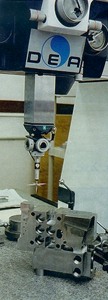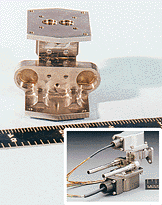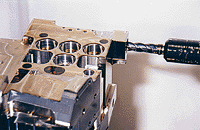The Systems Group of Moog Inc. tinkered with tradition a couple of years ago. Historically, our company has precision-machined the components we produce in-house. That had to change in late 1997 due to skyrocketing demand for our satellite and launch-vehicle control systems.
Our customers—manufacturers of satellites and launch vehicles—had reduced their lead times in response to the push to commercialize space, which fostered demand for data transmission equipment, cellular phones, pagers and direct-to-home television systems. This put pressure on us to do the same.
But how could we do it? Precision machining takes time. A big part of the solution involved forming a unique relationship with one of our suppliers.

One reason Magnus was chosen to help manufacture Moog's satellite and launch-vehicle control systems was that it had sufficient controls in place to minimize the production of nonconforming parts. Shown is the manifold for a thrust-vector control system being checked on Magnus' coordinate measuring machine.
Capacity Crunch
The problem of shortening our lead times was twofold: We had to find a way to design and develop products faster, and we needed to quickly increase our capacity.
The solution to the first part of our problem was already underway. In 1996, we had decided to upgrade our CAD/CAM system to Unigraphics. Implementation of this powerful software had already begun to speed product design and development. The second part of our problem, how to boost machining capacity, was tougher to crack.
As mentioned earlier, we have traditionally machined components in-house. Four hundred fifty of the approximately 1,900 employees at Moog’s East Aurora, N.Y., campus are machinists engaged in manufacturing parts for a broad line of products. These machined parts are assembled into finished products that are tested to rigid aerospace specifications.
Our line of launch-vehicle and satellite controls has rigorous requirements for high strength and low weight, is made from materials that are difficult to machine and requires tight tolerances and fine finishes. These constraints, coupled with stringent deburring and edge break limits, are a machining nightmare.
The requirements put Moog in a double-bind. Orders were flowing in and we had limited capability to fill them. As a short-term solution, we could farm the work out, but questions arose about the long-term consequences. If we were to utilize outside suppliers until we increased our internal capacity, how would we select, train and integrate them so they could understand and fulfill our stringent requirements? And if we decided to build up our own capacity, how would we leverage the time and money we had spent developing the relationship to continue to keep the supplier busy?
We decided to use a two-pronged approach: First, we would create additional capacity internally to produce these complicated parts. Second, we would partner with a supplier who had the capability and desire to help us tackle the short lead times and tough machining problems associated with this product line. The equipment to increase internal capacity would take about a year to acquire, so we had to bring a supplier on board quickly.
Supplier Selection
We decided to evaluate our existing pool of suppliers, finding one or two to begin with who—in addition to possessing the necessary machining capabilities—exhibited above-average performance with regard to quality and delivery. The chosen supplier(s) also needed to be close enough to travel to and from our plant in one day, willing to allow us to help process the parts and open to developing a relationship based on mutual trust.
The partnership we were proposing was a new way of doing business for us. But we knew that the benefits and advantages of such a relationship would far outweigh the costs and inconveniences.
A team of Moog employees, including shop supervisors and representatives from the purchasing, quality and methods departments, selected Magnus Manufacturing Corp. This supplier is located in Shortsville, N.Y., a two-hour trip from our plant.
“We needed to find a supplier who had the raw talent and proper equipment to make our kind of parts and the willingness to accept our help to get there,” said Moog’s corporate purchasing manager, Ed Minter. “It would be like making an Olympic-class sprinter from a runner who could do a 10-second, 100-yard dash. Magnus, it turned out, was that kind of company.
“We knew the transformation would take the full commitment of both parties,” Minter continued, “take more time than anticipated and include contentious moments wherein we would both ask, ‘Is it all worth it?’”
Magnus President Tom Farchione and Vice President Al Mustardo accepted the challenge. We began a series of meetings at Moog and Magnus to get to know each other better and to hammer out the details of this new arrangement.
“Sometimes, suppliers like us get led down the path of partnership and it turns into a dead end,” said Farchione. “This wasn’t the case with Moog. What I was most concerned with was what happens when we stumble? How would Moog react? Although it hasn’t always been smooth, we stuck to it and it has worked out.”
Job Transfers
Since the fabrication processes were well documented, we transferred the tooling and operation sheets for one of our propulsion-control-valve bodies to Magnus so that the first batch of parts was manufactured using processes that were identical to Moog’s (Figure 1).

Figure 1: The first component Magnus produced for Moog was a propulsion-control-valve body, which has unique deburring requirements. Magnus purchased the same type of deburring equipment that Moog owns to produce the valve. Inset: Propulsion-control-valve assembly.
Our unique deburring requirements proved to be particularly vexing for Magnus. Farchione and Mustardo surveyed Moog’s deburring stations and purchased an identical suite of equipment. Then, Magnus operators met with our deburring crew for training at Moog. In a short time Magnus was producing acceptable parts.
The next step was to work at process improvements. Initially, Magnus—mirroring a process performed at Moog—used less automated equipment to produce the valve. When Magnus switched to one of its horizontal machining centers, run times dropped significantly and quality didn’t diminish.
Moog’s director of quality, Bob Zent, said, “Our goal was to develop a supplier that had sufficient controls in place to minimize the production of nonconforming material. Additionally, when nonconforming material is produced, these controls should ensure that it is caught, identified and not shipped to Moog without proper disposition.”
Initially, Moog planned to only off-load existing work to Magnus to create capacity in our own shop for new jobs. But as new development orders kept arriving, we also needed to off-load some of this work to Magnus. Because of short lead times, we wanted to streamline the typical quote-to-order process, which involved mailing the drawings, waiting for responses, sorting those out and then placing an order.
We developed a capacity agreement. We promised to give Magnus a certain amount of work each month and, in turn, Magnus promised to reserve a certain amount of machining capacity, people and equipment for us. Moog’s shop supervisor, Jack Macholz, said that the arrangement has been very successful. The quote-to-order process, which used to take three to four weeks, now takes three to four days.
“As I receive orders for parts, I gauge my capacity based on delivery dates requested and do a quick make or buy (award the work to Magnus),” explained Macholz. “If it is a buy, I estimate nonrecurring hours and setup and run times. I then get the drawings to Magnus and they do the same. During an ensuing phone call, Al Mustardo at Magnus and I compare estimates, including requested delivery dates. If we agree on the numbers, he gets a purchase order immediately.”
In order to support this process, Moog negotiated hourly rates for Magnus’ machinists and manufacturing engineers. Additionally, when new work goes into production at Magnus, we apply a lower machining rate that compensates for the necessary learning curve.
Total Integration
It quickly became apparent that for some new work it was important for Magnus to view Moog’s designs as solid models, after they were created in Unigraphics. Furthermore, if Magnus could use the tool-path-generation capabilities of the UG software, our methods engineers would assist Magnus with NC programming.
Moog agreed to purchase a UG license for Magnus and provide training at no cost, while Magnus agreed to hire an NC programmer and buy a workstation. This proved to be fortuitous, for the job we tackled after the propulsion-valve body required all of our combined skills.
This new challenge involved machining a complex manifold that serves a vital function for a launch vehicle’s thrust-vector control system (Figure 2). The part was manufactured from 15-5 PH condition 1075 stainless steel. We originally machined the part in one of our production cells, but our capacity constraints made it a candidate for Magnus. Mustardo remembers the challenges that this job presented.

Figure 2: Manifold for a thrust-vector control being machined on a Magnus horizontal machining center.
“Since this manifold was part of a short development cycle at Moog, their traditional backup documents, such as detailed operation sheets and tooling packages, were not available,” said Mustardo. “So we had to create the solid model and tool paths ourselves with the help of Moog’s methods department. The machining techniques we codeveloped on this part allowed us to improve overall metal-removal rates, which have had direct application to Magnus’ commercial work. This was a win-win situation for both of us.”
Two years later, we are still engaged in the partnership and our additional equipment is producing similar parts. The amount of work given to Magnus has fluctuated with Moog’s business, although we have attempted to modulate that effect as best as possible in order to avoid sudden increases or decreases in orders. The relationship has evolved into one that allows Magnus to supply tooling and fixturing to Moog on a make-to-print basis.
Magnus’ Farchione is pleased with how the relationship between his company and Moog has evolved. “The result has been a mentoring type of relationship where machining knowledge developed at Moog is passed on to Magnus,” he said.
About the Author
Michael Baczkowski is the engineering hardware manager of the Systems Group at Moog Inc., East Aurora, N.Y.
Collaboration Considerations
One mistake that many companies make is rushing into a supplier partnership. Before you consider this kind of an arrangement with one of your suppliers, make sure you have realistic expectations.
Be prepared to put in a lot of time. A true partnership is like a marriage; if you don’t work at it, it falls apart. Distance does not make the heart grow fonder! Plan regular meetings at each other’s facilities so you can see each other face to face.
Make sure your partner has a company culture similar to your own. At Moog, we operate as a family, basing our behavior on mutual trust. Magnus is much the same; you can sense it when you visit the company’s facility.
Involve top management. It is important to the supplier and to your internal constituency to see that this is a companywide commitment. Moog’s general manager and vice president, R.C. Sherrill, accompanied the team on an early Magnus visit.
Involve affected employees. Be prepared for some resistance, because you are playing in other people’s sandboxes. They may be concerned that with work going outside, their workloads will decrease and they will become less important.
When issues come up—and they will—face them squarely. Don’t place too much emphasis on occasional poor delivery performance or quality escapes. They should not be viewed as an attempt by your partner to “take advantage” of your vulnerability and certainly aren’t reasons to end the relationship.
If you do decide to enter into a partnership, carefully examine your needs and the capabilities of your potential partners. You’ll instinctively know when you’ve found a perfect match.
— M. Baczkowski
Related Glossary Terms
- centers
centers
Cone-shaped pins that support a workpiece by one or two ends during machining. The centers fit into holes drilled in the workpiece ends. Centers that turn with the workpiece are called “live” centers; those that do not are called “dead” centers.
- machining center
machining center
CNC machine tool capable of drilling, reaming, tapping, milling and boring. Normally comes with an automatic toolchanger. See automatic toolchanger.
- numerical control ( NC)
numerical control ( NC)
Any controlled equipment that allows an operator to program its movement by entering a series of coded numbers and symbols. See CNC, computer numerical control; DNC, direct numerical control.
- precision machining ( precision measurement)
precision machining ( precision measurement)
Machining and measuring to exacting standards. Four basic considerations are: dimensions, or geometrical characteristics such as lengths, angles and diameters of which the sizes are numerically specified; limits, or the maximum and minimum sizes permissible for a specified dimension; tolerances, or the total permissible variations in size; and allowances, or the prescribed differences in dimensions between mating parts.
- solid model
solid model
3-D model created using “building blocks.” This is the most accurate way of representing real-world objects in CAD.
